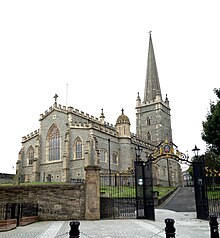
The Church of St Mary the Virgin, widely known as St Mary Redcliffe, is the main Church of England parish church for the Redcliffe district of the city of Bristol, England. The first reference to a church on the site appears in 1158, with the present building dating from 1185 to 1872. The church is considered one of the country's finest and largest parish churches as well as an outstanding example of English Gothic architecture. The church is so large it is sometimes mistaken for Bristol Cathedral by tourists. The building has Grade I listed status, the highest possible category, by Historic England.

The Cathedral Church of St. James is an Anglican cathedral in Downtown Toronto, Ontario, Canada. It is the location of the oldest congregation in the city, with the parish being established in 1797. The church, with construction beginning in 1850 and opening for services on June 19, 1853, was one of the largest buildings in the city at that time. It was designed by Frederick William Cumberland and is a prime example of Gothic Revival architecture.
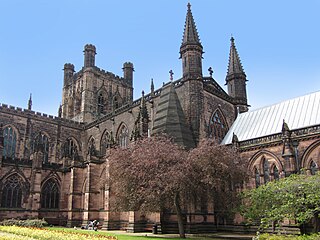
Chester Cathedral is a Church of England cathedral and the mother church of the Diocese of Chester. It is located in the city of Chester, Cheshire, England. The cathedral, formerly the abbey church of a Benedictine monastery dedicated to Saint Werburgh, is dedicated to Christ and the Blessed Virgin Mary. Since 1541, it has been the seat of the Bishop of Chester.

The Cathedral Church of St Colman, usually known as Cobh Cathedral, or previously Queenstown Cathedral, is a single-spire cathedral in Cobh, Ireland. It is a Roman Catholic cathedral and was completed in 1919. Built on Cathedral Place, it overlooks Cork harbour from a prominent position, and is dedicated to Colmán of Cloyne, patron saint of the Diocese of Cloyne. It serves as the cathedral church of the diocese.
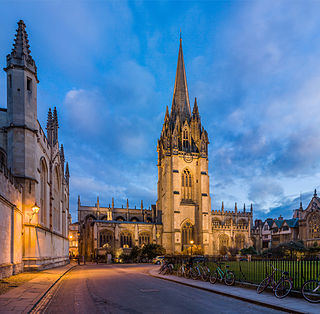
The University Church of St Mary the Virgin is an Anglican church in Oxford situated on the north side of the High Street. It is the centre from which the University of Oxford grew and its parish consists almost exclusively of university and college buildings.

Templemore, Clonmore and Killea is an ecclesiastical parish in the Roman Catholic Archdiocese of Cashel and Emly. The parish includes the town of Templemore and the nearby villages of Clonmore and Killea in County Tipperary.

The St Saviour's Cathedral is the heritage-listed cathedral church of the Anglican Diocese of Canberra and Goulburn in Goulburn, Goulburn Mulwaree Council, New South Wales, Australia. The cathedral is dedicated to Jesus, in his title of Saviour. The current dean is the Very Reverend Phillip Saunders. It was added to the New South Wales State Heritage Register on 20 April 2009.
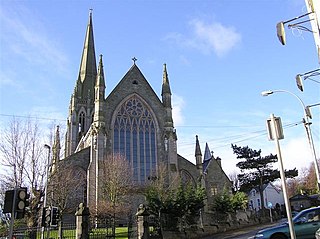
St Eugene's Cathedral is the Roman Catholic cathedral located in Derry, Northern Ireland. It is the "Mother Church" for the Roman Catholic Diocese of Derry, as well as the parish Church of the parish of Templemore.

The medieval cathedrals of England, which date from between approximately 1040 and 1540, are a group of twenty-six buildings that constitute a major aspect of the country's artistic heritage and are among the most significant material symbols of Christianity. Though diverse in style, they are united by a common function. As cathedrals, each of these buildings serves as central church for an administrative region and houses the throne of a bishop. Each cathedral also serves as a regional centre and a focus of regional pride and affection.
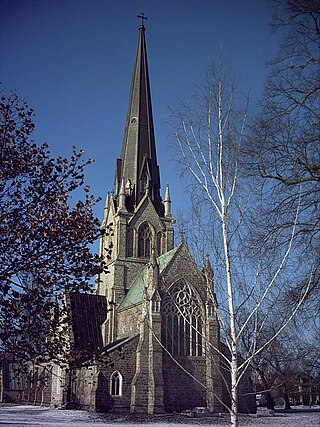
Christ Church Cathedral is the cathedral church of the Anglican Diocese of Fredericton. It is located in Fredericton, New Brunswick, Canada. Construction of the cathedral began in 1845 and it was consecrated in 1853. The Gothic Revival cathedral is modelled after St. Mary's Church, Snettisham, Norfolk.
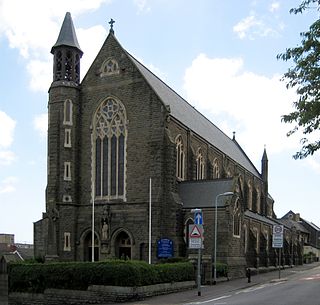
The Cathedral Church of Saint Joseph, also known as St Joseph's Cathedral, Menevia Cathedral or Swansea Cathedral, is a Grade II-listed Catholic cathedral in Swansea, Wales. It is the seat of the Bishop of Menevia and mother church of the Diocese of Menevia. The cathedral was built in the late nineteenth century and is located in the Greenhill area of Swansea.
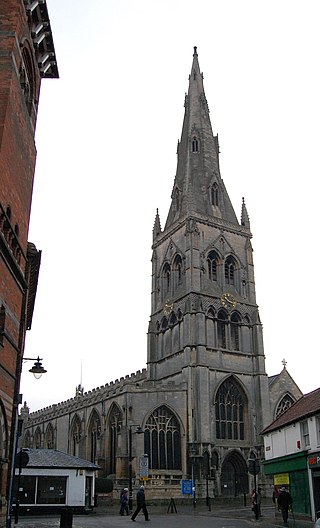
St Mary Magdalene Church, Newark-on-Trent is the parish church of Newark-on-Trent in Nottinghamshire, England. It is dedicated to Mary Magdalene and is the tallest structure in the town.

Wakefield Cathedral, or the Cathedral Church of All Saints in Wakefield, West Yorkshire, England, is a co-equal Anglican cathedral with Bradford and Ripon Cathedrals, in the Diocese of Leeds and a seat of the Bishop of Leeds. Originally the parish church, it has Anglo Saxon origins and, after enlargement and rebuilding, has the tallest spire in Yorkshire. Its 247-foot (75 m) spire is the tallest structure in the City of Wakefield. The cathedral was designated a Grade I listed building on 14 July 1953.

St Eunan's Cathedral ( YOO-nən, also known as Raphoe Cathedral, is one of two cathedral churches of the United Dioceses of Derry and Raphoe in the Church of Ireland. It is located in Raphoe, County Donegal and is dedicated to Saint Eunan who was abbot of Iona. The other diocesan cathedral is St Columb's Cathedral in Derry.

St Nicholas Church is a historic church in Westgate Street in the city of Gloucester, England, under the care of The Churches Conservation Trust. It is recorded in the National Heritage List for England as a designated Grade I listed building. Its truncated spire is a landmark in the city centre.

The Church of St Peter, Carrigrohane, is a Gothic Revival church in Cork, Ireland. It belongs to the Church of Ireland and was constructed in 1854, and extended by William Burges in 1865–68. The church is located on Church Hill, Carrigrohane, to the west of Cork city. It stands on the site of an earlier church, and is dedicated to Saint Peter. Along with the Church of the Resurrection and St Senan's Church it is part of the Carrigrohane Union of Parishes in the Diocese of Cork, Cloyne, and Ross.
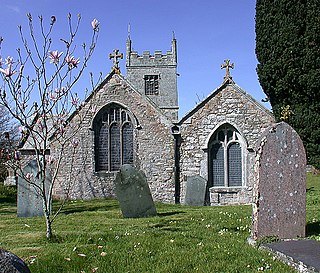
Colan Church also known as St Colan Church is a 13th-century church in Colan, mid-Cornwall, UK. Dedicated to St Colanus, it became a Grade I listed building in 1967. The vicars of St Columb Minor have served the church since the middle of the 20th century.

The Church of St Mary the Virgin is a parish church of the Church of England in Baldock in Hertfordshire. Dedicated to the Virgin Mary, the original church on the site dated to about 1150 and was built by the Knights Templar before being largely rebuilt in about 1330 by the Knights Hospitaller. It is a Grade I listed building.

St Botolph's Church is an Anglican church in Quarrington in Lincolnshire, England.

Perpendicular Gothic architecture was the third and final style of English Gothic architecture developed in the Kingdom of England during the Late Middle Ages, typified by large windows, four-centred arches, straight vertical and horizontal lines in the tracery, and regular arch-topped rectangular panelling. Perpendicular was the prevailing style of Late Gothic architecture in England from the 14th century to the 17th century. Perpendicular was unique to the country: no equivalent arose in Continental Europe or elsewhere in the British Isles. Of all the Gothic architectural styles, Perpendicular was the first to experience a second wave of popularity from the 18th century on in Gothic Revival architecture.
